Allocating Costs from Project-to-Project
|
Page Name |
Definition Name |
Usage |
|---|---|---|
|
ALLOC_CALC_OPTN |
Define the allocation type and any special arithmetic operations that you want to perform by using the pool and basis. Select a transaction code for use in interunit and intraunit allocations. |
|
|
ALLOC_POOL |
Define the allocation pool record, selection criteria, and selection method. |
|
|
ALLOC_BASIS |
Specify how and in what proportion the pool amounts are distributed to the various targets. |
|
|
ALLOC_TARGET |
Define the destination for the allocation or target record and target field values. |
|
|
Define Allocation Step - Offset Page |
ALLOC_OFFSET |
Define the offset entry that balances the target. |
|
Define Allocation Step - Output Options Page |
ALLOC_OUT_JRL_OPTN |
Define journal output options if the target or offset record is Journal Records. Define table output options if the target or offset record is Any Table. |
|
Define Allocation Step - Round Options Page |
ALLOC_ROUND_OPTN |
Define the method for rounding the allocation amount and distributing odd cents for the Spread Evenly, Allocate of Fixed Basis, and Prorata with Record Basis allocation types. |
|
ALLOC_RECNAME |
Specify the batch temporary tables that the Allocations process uses. |
|
|
ALLOC_AMOUNT |
Define the amount field mapping between the pool, basis, target, and offset records. |
|
|
ALLOC_REQUEST |
Specify parameters and run the Allocations process. |
PeopleSoft provides sample data that contains a project-to-project allocation step called PC_TO_PC that has a SetID of SHARE. This allocation step is an example of periodically allocating costs to activities based on the total costs that are incurred for each of the activities. In this example, the BUILDING project collects storage costs that are associated with a child project COMPLEX and its activities EXCAVATION, FOUNDATION, and STRUCTURAL.
Note: This topic discusses the field values that are required to set up the example PC_TO_PC allocation step. A detailed discussion of the Define Allocation Step component (ALLOCATIONS) is in the Defining Allocation Process Steps topic.
Project Activity Costs Accumulation and Allocation
The total storage cost collected in the current period by project BUILDING for its child project COMPLEX is 1,000,000 USD. This is a sum of all storage cost transactions associated with project BUILDING in business unit US003. This pool amount is to be distributed to the child project COMPLEX and its three activities. This table shows the total costs currently incurred by each of the activities within project COMPLEX:
|
Activity |
Cost Incurred |
|---|---|
|
EXCAVATION |
200,000 USD (25% of total) |
|
FOUNDATION |
200,000 USD (25% of total) |
|
STRUCTURAL |
400,000 USD (50% of total) |
When you run the PC_TO_PC allocation example, the system distributes the 1,000,000 USD pool amount among the three activities of project COMPLEX with the same ratio that currently exists between them, as illustrated in this table:
|
Activity |
New Distribution Rows Based on Allocations |
|---|---|
|
EXCAVATION |
250,000 USD (25% of 1,000,000 USD) |
|
FOUNDATION |
250,000 USD (25% of 1,000,000 USD) |
|
STRUCTURAL |
500,000 USD (50% of 1,000,000 USD) |
This diagram illustrates the process of allocating activity costs using the PC_TO_PC allocation step:
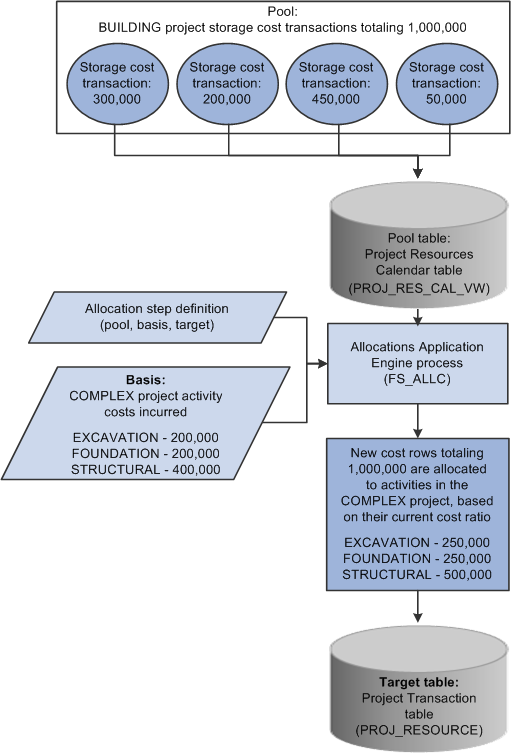
Use the Define Allocation Step - Type page (ALLOC_CALC_OPTN) to define the allocation type and any special arithmetic operations that you want to perform by using the pool and basis.
Select a transaction code for use in interunit and intraunit allocations.
Navigation:
This example illustrates the fields and controls on the Define Allocation Step - Type page. You can find definitions for the fields and controls later on this page.

The allocation type defines how the pool amount is distributed to the target.
Field or Control |
Description |
|---|---|
Allocation Type |
To allocate the pool amount to the three activities using a ratio based on their current costs, the PC_TO_PC allocation step uses an allocation type of Prorata with Record Basis. This allocation type requires a basis definition, because it divides the pool amount among the targets based on amounts stored in the basis record. |
Use the Define Allocation Step - Pool page (ALLOC_POOL) to define the allocation pool record, selection criteria, and selection method.
Navigation:
This example illustrates the fields and controls on the Define Allocation Step - Pool page. You can find definitions for the fields and controls later on this page.
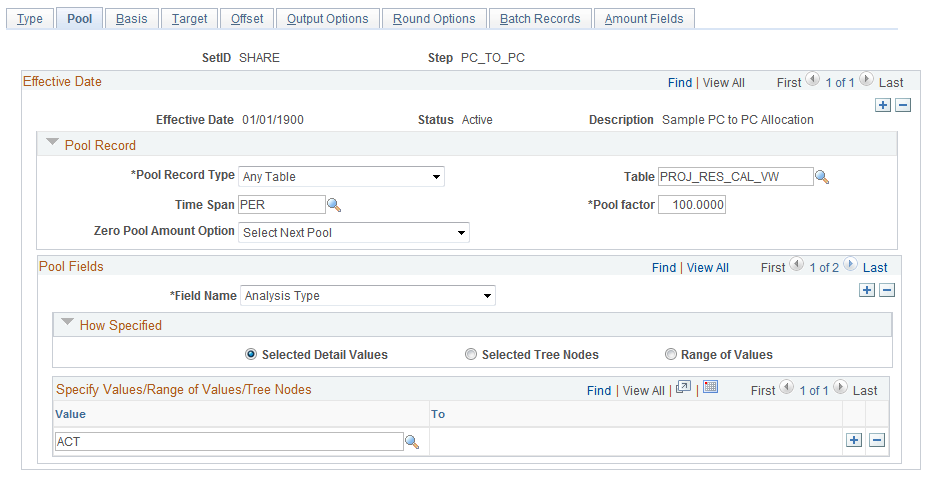
The allocation pool defines the amount to be allocated.
Field or Control |
Description |
|---|---|
Pool Record Type |
Use Any Table as the record type for PeopleSoft Project Costing. |
Table |
For the PC_TO_PC allocation step, the system uses the accumulated source transactions for project BUILDING with analysis type ACT (actual cost) within the current fiscal period to distribute to the activities. Fiscal year and accounting period information must be available when the time span is the current period; therefore, the table that the system uses to retrieve the pool amount must contain the Fiscal Year field (FISCAL_YEAR) and Accounting Period field (ACCOUNTING_PERIOD). The PC_TO_PC allocation step uses the Project Resources Calendar table (PROJ_RES_CAL_VW) to retrieve the pool amount. The Project Resources Calendar table is a view of the Project Transaction table (PROJ_RESOURCE) table joined with the CALENDAR table. Click the View All link for the Pool Fields scroll area to see that the pool amount that is allocated to the activities, in this example, is based on the BUILDING project for the ACT analysis type. |
Zero Pool Amount Option |
Select Next Pool tells the system to skip a zero amount pool record and select the next pool record to process. |
Time Span |
The PC_TO_PC allocation step uses PER (current period transactions), indicating that the system only retrieves transactions that are in the current accounting period to calculate the pool amount. |
Add another row to the Pool Fields grid, enter field name Project, and enter the project ID BUILDING that contains the activity costs that you are accumulating.
Pool Fields
Field or Control |
Description |
|---|---|
Field Name |
The first row identifies Analysis Type as a field that the PC_TO_PC allocation step uses to identify the pool. The second row identifies Project to further narrow the pool. |
Value |
Typically, the ACT analysis type is used as the analysis type for the pool record because it represents all actual costs that are accumulated in the Project Transaction table for the specified project activity. In the second row, BUILDING identifies the project that accumulates the transactions that you want to allocate. |
Use the Define Allocation Step - Basis page (ALLOC_BASIS) to specify how and in what proportion the pool amounts are distributed to the various targets.
Navigation:
This example illustrates the fields and controls on the Define Allocation Step - Basis page. You can find definitions for the fields and controls later on this page.
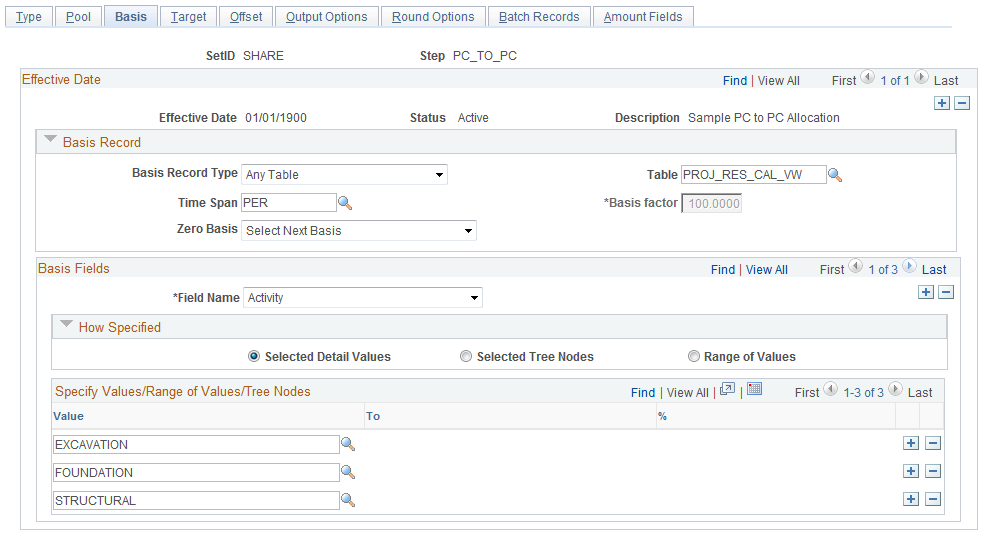
The basis defines how the pool is allocated across the target.
Field or Control |
Description |
|---|---|
Table and Time Span |
The PC_TO_PC allocation step uses the Project Resources Calendar table as the basis table, since the system uses only transactions within the current period (time span of PER) to determine the percentage allocation for each activity. |
Basis Fields
To allocate the pool amount to the three activities using a ratio based on their current costs, the PC_TO_PC sample allocation step has a type of Prorata with Record Basis, which requires a basis definition. The system uses basis rows to determine how to split the pool amount among the target rows.
Field or Control |
Description |
|---|---|
Field Name and Value |
Three rows appear in the Basis Fields grid, specifying that the system retrieves transactions for project COMPLEX and activities EXCAVATION, FOUNDATION, and STRUCTURAL, with an analysis type of ACT. The system calculates the current costs for each activity. Since the target project and activity are defined by the basis, the pool amount is split among the three activities of the project in the same proportion as their respective current cost. |
Click the View All link for the Basis Fields scroll area to see that the basis of the allocation is the accumulated costs prior to the current allocation that is recorded in the BUILDING project for the ACT analysis type in the EXCAVATION, FOUNDATION, and STRUCTURAL activities.
Use the Define Allocation Step - Target page (ALLOC_TARGET) to define the destination for the allocation or target record and target field values.
Navigation:
This example illustrates the fields and controls on the Define Allocation Step - Target page. You can find definitions for the fields and controls later on this page.
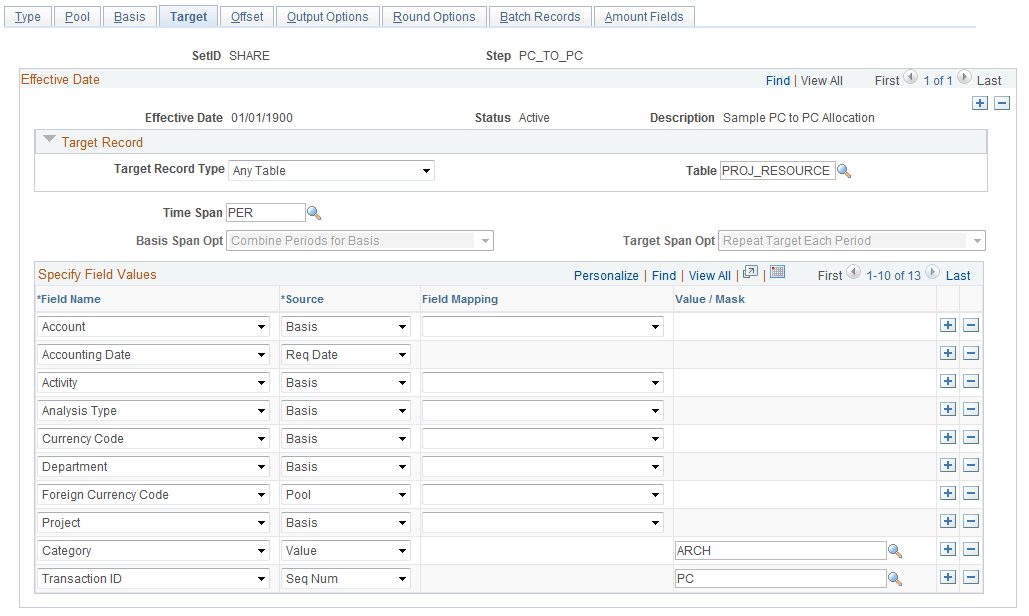
The allocation creates new rows in the Project Transaction table. You must specify field values for which you want specific values from the allocation process. You must also specify the field value source, such as pool, basis, fixed value, or sequence number.
Field or Control |
Description |
|---|---|
Table |
The PC_TO_PC allocation step uses the Project Transaction table as the target record. Note: If you use the Project Transaction table as the target, you must also manually run any project-related processes on the allocation rows. |
Specify Field Values
In the Specify Field Values grid, define the fields for which you want specific values and define the source (pool, basis, specific value, sequence number, and so forth) from where the values originate. Include keys fields and other fields that are mandatory for processing.
To distinguish new allocation rows from the original cost rows, enter field name Analysis Type, with a source of Value, and a value/mask that is a different analysis type than the original cost rows. To summarize transactions across dates, enter field name Transaction Date with a source of Req Date (request date). To summarize rows by individual date, enter field name Transaction Date with a source of Pool.
Important! To ensure uniqueness in the resulting table, specify the Transaction ID field (RESOURCE_ID) as a target field, and select Seq Num (sequence number) as the source.
Each new row that the Allocations process adds to the target table contains values only for the fields that you list in the Target page. The values are based on the source location specified in the Source column.
The fields listed in the Target page not only specify the fields to copy to the new allocation rows in the target record, but also they implicitly specify the level at which you want to summarize allocation rows. If you specify fields to be populated from the basis or pool, the Allocations process summarizes the rows based on unique values of these fields. If you want the Allocations process to ignore a particular field and summarize all rows regardless of the field's value, you can either not specify the field in the Target page, or specify the field with a constant value. There are most likely many more fields in the target record than you will list in the Target page. The fields that are not listed in the Target page will not contain data in the new rows that the Allocations process creates.
An offset is not necessary in this example because the table output option is Replace Existing Amounts.
Use the Define Allocation Step - Batch Records page (ALLOC_RECNAME) to specify the batch temporary tables that the Allocations process uses.
Navigation:
This example illustrates the fields and controls on the Define Allocation Step - Batch Records page. You can find definitions for the fields and controls later on this page.
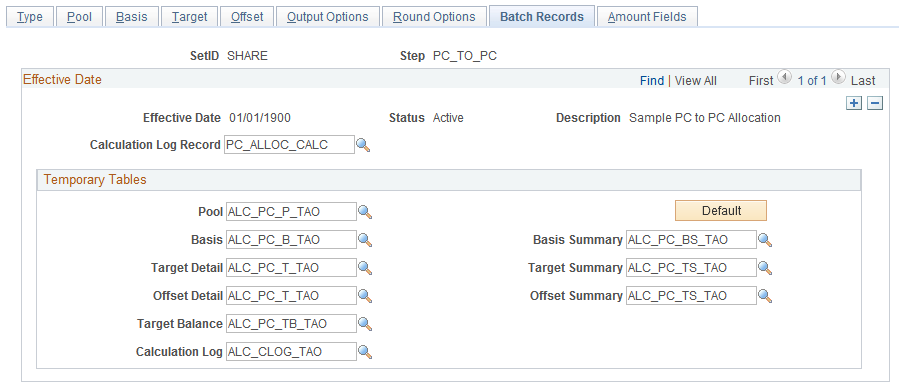
Batch records are temporary work records that store the calculations and log files for the Allocations process.
PeopleSoft delivers these temporary work records for use in both PeopleSoft General Ledger and PeopleSoft Project Costing allocations:
|
Temporary Work Record |
Record Name |
|---|---|
|
Calculation Log Record |
PC_ALLOC_CALC |
|
Pool |
ALC_PC_P_TAO |
|
Basis |
ALC_PC_B_TAO |
|
Basis Summary |
ALC_PC_BS_TAO |
|
Target Detail Offset Detail |
ALC_PC_T_TAO |
|
Target Summary Offset Summary |
ALC_PC_TS_TAO |
|
Target Balance |
ALC_PC_TB_TAO |
|
Calculation Log |
ALC_CLOG_TAO |
Use the Define Allocation Step - Amount Fields page (ALLOC_AMOUNT) to define the amount field mapping between the pool, basis, target, and offset records.
Navigation:
This example illustrates the fields and controls on the Define Allocation Step - Amount Fields page. You can find definitions for the fields and controls later on this page.
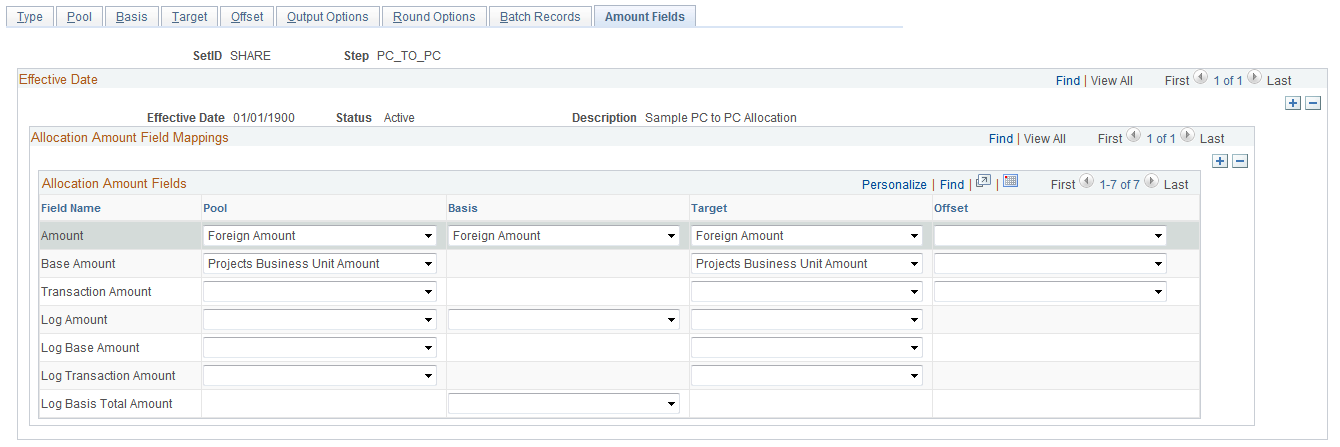
Amount fields define the fields that store pool, basis, target, and, if applicable, offset amounts. Use this page to define how to distribute the amounts from the fields in the pool record to the fields in the target and offset records.
Allocation Amount Fields
Specify the appropriate amount fields for both the foreign currency and base currency amounts. If you use the Project Resources Calendar table and Project Transaction table as the pool, basis, or target table, select Foreign Amount (FOREIGN_AMOUNT) for the Amount fields and Projects Business Unit Amount (RESOURCE_AMOUNT) for the Base Amount fields.
Use the Allocation Request page (ALLOC_REQUEST) to specify parameters and run the Project-to-Project Allocation process.
Navigation:
Use this page to run the sample PC_TO_PC allocation group that contains the PC_TO_PC allocation step. The system allocates the pool amount to the target record, based on the criteria in the basis fields.